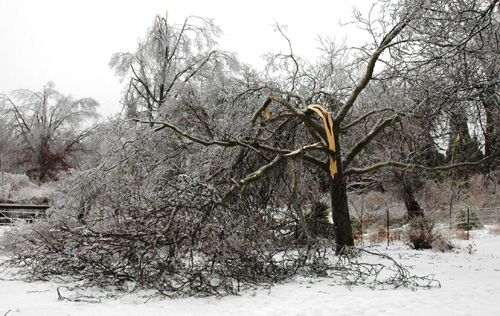As winter settles in, it brings with it the beauty of snow-covered landscapes and crisp, cold air. However, along with these picturesque scenes comes a significant risk to property and personal safety—falling branches and trees. While trees may seem sturdy and resilient, the winter months can place immense stress on them, leading to hazardous situations.
Why Do Branches and Trees Fall in Winter?
Several factors contribute to the increased risk of tree failure during the winter season. Let’s explore some of the main reasons:
1. Heavy Snow and Ice Accumulation
Winter storms often bring significant snow and ice, which can accumulate on branches. The weight of this snow and ice can quickly overwhelm a tree, especially if the branches are already weakened. The added weight strains the tree’s structure, potentially causing branches to snap or even entire trees to topple. Coniferous trees, such as pines and spruces, are particularly vulnerable to snow and ice buildup because their branches are designed to hold snow, but they aren't always strong enough to bear excessive weight.
2. Freezing Temperatures
Freezing temperatures can also impact a tree’s health and structural integrity. When water inside the tree’s cells freezes, it can cause the cells to burst, leading to internal damage. Over time, this internal injury weakens the tree, making it more prone to breaking, even in less severe weather.
3. Wind and Storms
Winter storms are not just about snow and ice—they also bring high winds, which can exacerbate the effects of freezing temperatures. Strong winds can push snow-covered branches out of alignment or cause trees with already weakened root systems to topple. This is especially dangerous in areas with poorly established or shallow-rooted trees.
4. Decreased Flexibility
During the winter, trees enter a dormant phase, which means their cells and tissues are less flexible. A frozen or dormant tree is less able to "bend" or sway in response to stress from the wind or heavy snow. Without this ability to flex, branches are more likely to snap when pushed.
5. Diseased or Dead Trees
Trees that are diseased or already dead are at a much higher risk of falling during winter. The absence of healthy tissue or a compromised root system can make it more difficult for these trees to stand strong against the elements.
The Risks Posed by Falling Trees and Branches
Falling branches or trees during the winter months can lead to severe consequences, ranging from property damage to personal injury. Here are some of the most common risks:
Property Damage: Large branches or trees that fall on homes, cars, fences, and power lines can cause significant damage. Broken windows, damaged roofs, and smashed vehicles are common outcomes of falling branches.
Personal Injury: If you’re walking or driving near trees, the risk of injury is very real. Branches can fall with little warning, and the impact can cause serious harm. Winter storms can also make the ground slippery, increasing the chance of accidents when branches fall.
Power Outages: Fallen branches and trees can take down power lines, leaving entire neighborhoods without electricity. Power outages in the winter can be especially dangerous, as people rely on heat and light to stay safe.
Conclusion
Winter brings a unique set of challenges for homeowners when it comes to trees and falling branches. While the season's beauty is undeniable, the hidden dangers posed by snow, ice, and freezing temperatures shouldn't be overlooked. By staying proactive with tree maintenance and being mindful of the risks, you can better protect your property and loved ones from the hazards of winter storms. Stay safe, and enjoy the winter season—just with a little extra caution when it comes to the trees around you!
Get a quote done for that tree that is looking rough and might be a little too close to your home, have our team clear the debris that has been collecting in your yard from the winter storms or have a risk assessment done by our highly trained team.

